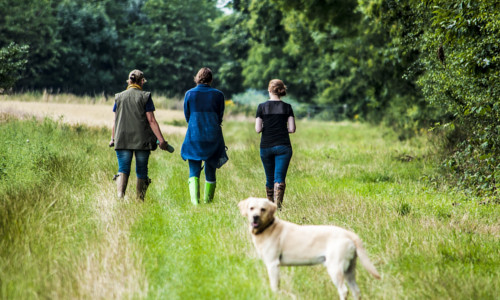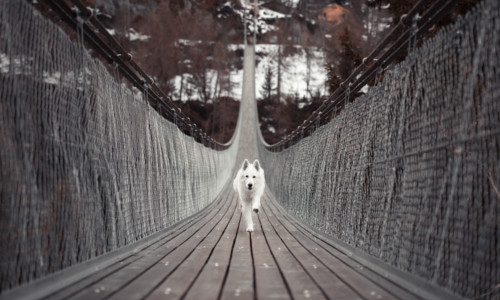Enhance the Endurance of Your Dog by Following These Tips
Author

A keen runner, skier and nuts about cycling. Karl lives in Cumbria, where he loves encouraging his two children to follow in his outdoor lifestyle. Whilst out and about keeping active, Karl keeps a diary and shares it with Outdoor Look.
 I belong to an active family. Sitting at home doing nothing over an extended holiday was never part of my DNA. But things changed when I moved over to a different location, away from my family, due to work reasons. With choked up schedule and no time to make friends, I was stuck in my 9 to 5 job. Many times I thought about going out for a hike, but had to drop the plans as I was unable to find a partner.
I belong to an active family. Sitting at home doing nothing over an extended holiday was never part of my DNA. But things changed when I moved over to a different location, away from my family, due to work reasons. With choked up schedule and no time to make friends, I was stuck in my 9 to 5 job. Many times I thought about going out for a hike, but had to drop the plans as I was unable to find a partner.
One fine evening, after coming home from office, I was watching Turner and Hooch. The camaraderie between the dog and Tom Hanks got me hooked, and it was then I decided to bring Ronny, my dog, into my world. He became my accomplice on morning jogs, never tiring and always following me throughout the run. That’s when I got the idea to plan a hike with my Labrador. The next weekend I sat about on my journey with Ronny. He was so excited; it was palpable from his loud barks. Our first hike brought us immense pleasure and led to more hikes in the future. A lot of effort went into training Ronny before our first hike. Below I have jotted down a few tips that you can follow for an awesome hiking experience with your dog.
1. Know the Breeds
If you do not already have a dog at your home, pay special attention to the breed. Avoid short-faced dogs as they have a hard time breathing which makes them a lousy hiking partner. Bulldogs, Pugs, and Boston Terriers are not ideal for a long hike. Even taller dogs like Mastiffs, and Great Danes are not suited for hikes as they are prone to bone related problems. I am lucky to have a Labrador as my hiking partner but there are a few other breeds that are equally adept at running and hiking. Vizsla, Weimaraner, and Australian Cattle dog can be awesome partners on a hiking adventure.
2. Right Time To Run With The Puppy
It is normally advised to a dog owner that he should not take his dog for a hike till he is at least one year old. However, I started training with Sam when he was younger than one year. He was fine chasing after me at such a young age without tiring easily. I advise you to do light walking and running with a young pup when he is a few months old and gradually increase the intensity. Wasting a complete year is not required.
 3. Leashed or Unleashed
3. Leashed or Unleashed
When you are only concerned about the happiness of your dog, then unleashing him is a no-brainer. If you have a dog-friendly neighbourhood, then you can be carefree when he is unleashed. But such neighbourhoods are a rarity and hence, you should keep your dog on a leash when he walking with you in a populated area. When you head out for open spaces, you can allow your dog to run free without a leash. If somehow you are unable to train your dog to run without a leash, in that case, it is a good idea to tie the other end of the leash to your waist. This way you won’t be thrown off balance by his persistent pulls.
4. Health Concerns
The biggest enemy of a dog on a hike is hot weather. Plan your training at dawns and dusks in order to reduce your dog’s exposure to the sun. You should be careful running with the dog when the temperature reaches 20ºC. Anything above 25ºC and you should stop running. By restricting exposure of your dog to the energy sapping heat, you will make sure that he stays energetic and healthy throughout the hike.
Author

A keen runner, skier and nuts about cycling. Karl lives in Cumbria, where he loves encouraging his two children to follow in his outdoor lifestyle. Whilst out and about keeping active, Karl keeps a diary and shares it with Outdoor Look.
Categories
- Sport (28)
- Product Reviews (3)
- Team Outdoor Look (7)
- Mike Wild (2)
- Mike Payton (2)
- Suse Hammond-Pears (3)
- Snowboarding (12)
- Latest Offers (105)
- Shop Talk (1)
- Competitions (7)
- Walking (413)
- Lifestyle Fashion (8)
- Travel (86)
- Kit Guides (176)
- Workwear Clothing (6)
- Safety Workwear (4)
- Health/Fitness (289)
- Skiing (91)
- Great Outdoors (1316)
- Cycling (92)
- January 2025
- December 2024
- November 2024
- October 2024
- September 2024
- August 2024
- July 2024
- June 2024
- May 2024
- April 2024
- March 2024
- February 2024
- January 2024
- December 2023
- November 2023
- October 2023
- September 2023
- August 2023
- July 2023
- June 2023
- May 2023
- April 2023
- March 2023
- February 2023
- January 2023
- December 2022
- November 2022
- October 2022
- September 2022
- August 2022
- July 2022
- June 2022
- May 2022
- April 2022
- March 2022
- February 2022
- January 2022
- December 2021
- November 2021
- October 2021
- September 2021
- August 2021
- July 2021
- June 2021
- May 2021
- April 2021
- March 2021
- February 2021
- January 2021
- December 2020
- November 2020
- October 2020
- September 2020
- August 2020
- July 2020
- June 2020
- May 2020
- April 2020
- March 2020
- February 2020
- January 2020
- December 2019
- November 2019
- October 2019
- September 2019
- August 2019
- July 2019
- June 2019
- May 2019
- April 2019
- March 2019
- February 2019
- January 2019
- December 2018
- November 2018
- October 2018
- September 2018
- August 2018
- July 2018
- June 2018
- May 2018
- April 2018
- March 2018
- February 2018
- January 2018
- December 2017
- November 2017
- October 2017
- September 2017
- August 2017
- July 2017
- June 2017
- May 2017
- April 2017
- March 2017
- February 2017
- January 2017
- December 2016
- November 2016
- October 2016
- September 2016
- August 2016
- July 2016
- June 2016
- May 2016
- April 2016
- March 2016
- February 2016
- January 2016
- December 2015
- November 2015
- October 2015
- September 2015
- August 2015
- July 2015
- June 2015
- May 2015
- April 2015
- March 2015
- February 2015
- January 2015
- December 2014
- November 2014
- October 2014
- September 2014
- August 2014
- July 2014
- June 2014
- May 2014
- April 2014
- March 2014
- February 2014
- January 2014
- December 2013
- November 2013
- October 2013
- September 2013
- August 2013
- July 2013
- June 2013
- May 2013
- April 2013
- March 2013
- February 2013
- January 2013
- December 2012
- November 2012
- October 2012
- September 2012
- August 2012
- July 2012
- June 2012
- May 2012
- April 2012
- March 2012
- February 2012
- January 2012
- December 2011
- November 2011
- October 2011
- September 2011
- August 2011
- May 2010
- April 2010
- March 2010
- February 2010
- January 2010
- November 2009
- October 2009
- September 2009
Submit a Comment